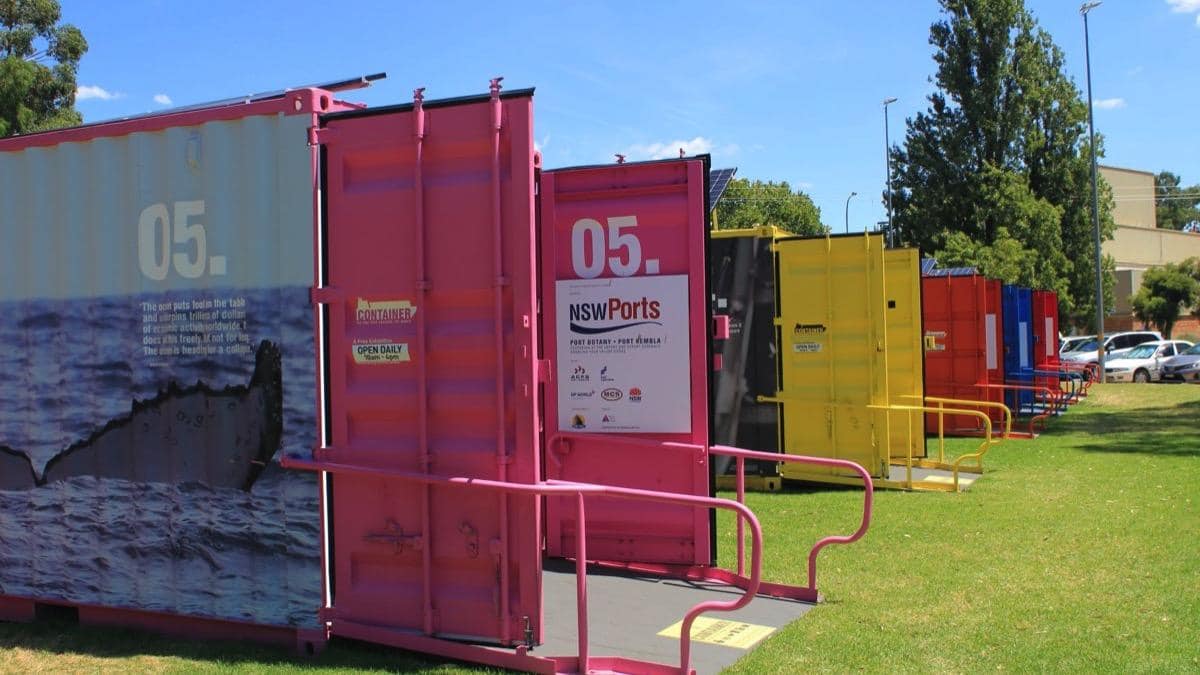Today the ‘Box that changed the world- the Container Exhibition’ officially opened in Wagga Wagga as part of a tour of regional NSW.
NSW Ports is proud to be a major sponsor of this exhibition which has seen over 200,000 visitors to date at Darling Harbour and Wollongong. Housed entirely within six 20-foot shipping containers, the exhibit invites visitors to explore the technical, economic, environmental, social and cultural impacts of containerisation.
Speaking at the opening today, which was attended by representatives of the shipping and transport industry and special guests from the Riverina business community, Chief Executive Officer, NSW Ports Marika Calfas said “‘Container’ is a valuable educational resource. By supporting and contributing to its creation NSW Ports is helping the community understand the crucial role ports play in our lives and in the economy.”
NSW Ports worked with the National Australian Maritime Museum to create a ‘travelling exhibition’ that has already visited Darling Harbour and Wollongong.

Pictured: Kevin Sumption, Director and CEO National Australian Maritime Museum, Marika Calfas CEO of NSW Ports and Mayor of Wagga Wagga Cr Greg Conkey.
“Containers connect us with global markets and support our lifestyles. They connect Wagga Wagga and the Riverina region with overseas export markets and bring overseas products destined for the region into the country. The beauty of an exhibition in containers is that it can travel throughout NSW to reach as many people as possible.” Ms Calfas said.
“Port Botany and Port Kembla are the engine room that support the NSW economy and our standard of living in cities and regions. They connect us with global and domestic markets. Our ports contribute $4.4Bn a year to the State’s economy and employ 29,000 people.”
“The Riverina region benefits from rail and road access to Port Botany: the premium NSW container port with key competitive advantages*. NSW Ports continues to invest so that Port Botany is the port of choice for regional businesses in NSW. We want exporters in regional NSW to take advantage of our surplus of empty containers. We would like to have more of them exported full”.
“We continue to invest in productivities and efficiencies at Port Botany and Port Kembla. Together with our tenants we have invested $1.6 Bn over the past 5 years and have $450m of committed expenditure in place. We see efficient connections to and from Port Botany as vital to keeping supply chain costs low, to reduce cost of goods to families and businesses and keep our exports competitive.”
“Exporters and importers in the Riverina and other regional centres in NSW are valued port users, relying on connections to Port Botany to help them get their products to market. This is why NSW Ports is investing up to $120 million to double port side rail capacity from 750,000 to 1.5 million TEUs at Port Botany.
“Faster servicing of trains at Port Botany will translate to time savings for rail operators and should lead to cost savings for farmers and other regional exporters”.
-Ends-
*Port Botany’s Competitive Advantages:
- The only container port in Australia with ‘on-dock’ rail facilities at all three stevedore terminals.
- $120 million investment to double rail capacity resulting in time savings for operators and cost savings for regional exporters.
- 86% of regional NSW exports arrive by rail.
- The only container port in Australia (and possibly the world) with:
- a regulated truck booking / penalty system which has removed truck queuing from container terminals anddelivered savings to importers and exporters
- world class performance based stevedore leases that have financial incentives for stevedores to improve performance in ship, road and rail servicing.
- environmental incentives for ships – launched in January this year this initiative is to encourage, through financial incentives, vessels with higher standards of environmental emissions performance in our ports.
About the Container Exhibition:
Each of the six colourful containers in the exhibition has a specific theme:
SHIP - Learn the history of transporting goods in crates, bales, sacks and barrels loaded by hand, and how the container now allows the world's 1.5 million seafarers to deliver 10 billion tonnes of trade each year.
CARGO - Discover the intricate world of trade, customs, and biosecurity, and how perishable goods are transported around the world in the 'cold' chain.
PORT - See the radical transformation of ports and port cities in Australia and around the world. Have a peek behind the scenes at Port Botany, one of Australia's busiest ports and the gateway for 99 per cent of New South wales' container demand.
OCEAN - Explore the challenges mass shipping poses to our oceans, including lost shipping containers, cargo spills and acoustic pollution, and the current focus on sustainable shipping.
BUILD - Be delighted by the quirky and innovative ways containers are used beyond shipping, including ‘small homes’, food trucks, art installations and even swimming pools.
THINGS - Enter a glass-fronted container demonstrating the origins of everyday objects in our homes. The total number of kilometres travelled by sea by all the products in this container is 887,082 km.

